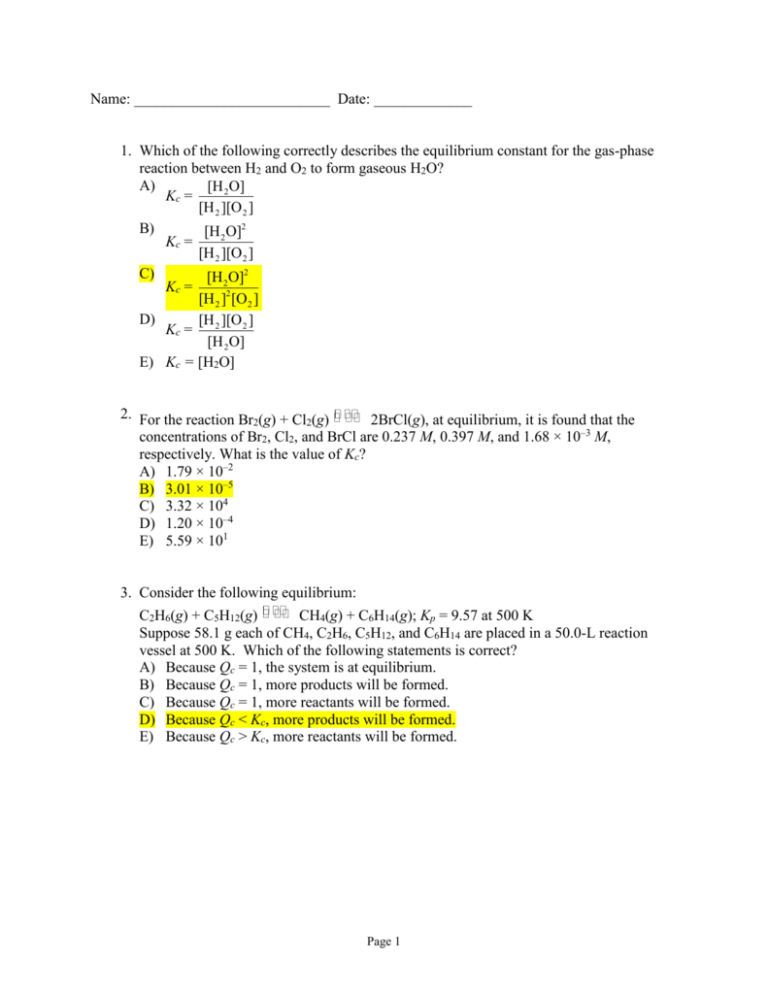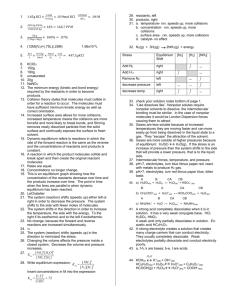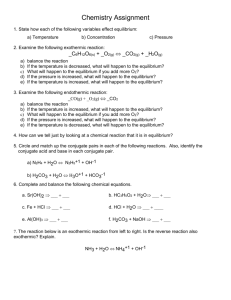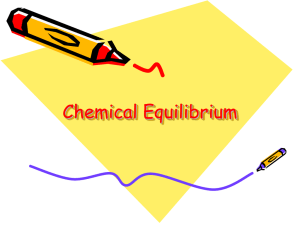CHM 1046 PRACTICE EXAM #3 answers
advertisement

Name: __________________________ Date: _____________ 1. Which of the following correctly describes the equilibrium constant for the gas-phase reaction between H2 and O2 to form gaseous H2O? A) [H 2 O] Kc = [H 2 ][O 2 ] B) [H 2 O]2 Kc = [H 2 ][O 2 ] C) [H 2O]2 Kc = [H 2 ]2 [O2 ] D) [H 2 ][O 2 ] Kc = [H 2 O] E) Kc = [H2O] 2. For the reaction Br2(g) + Cl2(g) 2BrCl(g), at equilibrium, it is found that the concentrations of Br2, Cl2, and BrCl are 0.237 M, 0.397 M, and 1.68 × 10–3 M, respectively. What is the value of Kc? A) 1.79 × 10–2 B) 3.01 × 10–5 C) 3.32 × 104 D) 1.20 × 10–4 E) 5.59 × 101 3. Consider the following equilibrium: C2H6(g) + C5H12(g) CH4(g) + C6H14(g); Kp = 9.57 at 500 K Suppose 58.1 g each of CH4, C2H6, C5H12, and C6H14 are placed in a 50.0-L reaction vessel at 500 K. Which of the following statements is correct? A) Because Qc = 1, the system is at equilibrium. B) Because Qc = 1, more products will be formed. C) Because Qc = 1, more reactants will be formed. D) Because Qc < Kc, more products will be formed. E) Because Qc > Kc, more reactants will be formed. Page 1 4. Which of the following equilibria would not be affected by pressure changes at constant temperature? A) CO(g) + ½O2(g) CO2(g) B) CaCO3(s) CaO(s) + CO2(g) C) 2Hg(l) + O2(g) 2HgO(s) D) CO2(g) + H2(g) CO(g) + H2O(g) E) 2H2(g) + O2(g) 2H2O(l) 5. Which of the following statements is incorrect concerning the addition of a catalyst to an equilibrium reaction system? A) The catalyst increases the rate of both the forward and the reverse reaction. B) If the reactants are capable of forming many different products, a catalyst may selectively speed up one reaction over another. C) The catalyst speeds up the attainment of equilibrium. D) The catalyst increases the yield of the products. E) The catalyst is not consumed in either the forward or the reverse reaction. 6. Which of the following is true for a system whose equilibrium constant is relatively small? A) It will take a short time to reach equilibrium. B) It will take a long time to reach equilibrium. C) The equilibrium lies to the left. D) The equilibrium lies to the right. E) Two of these are true. 7. Consider the following equilibrium: PCl3(g) + Cl2(g) PCl5(g); H = –92 kJ The concentration of PCl3 at equilibrium may be increased by A) increasing the pressure. B) adding Cl2 to the system. C) decreasing the temperature. D) the addition of neon. E) the addition of PCl5. 8. Which of the following statements is incorrect? A) An Arrhenius base is an electron-pair acceptor. B) An Arrhenius acid increases the concentration of hydronium ion. C) A Brønsted–Lowry base is a proton acceptor. D) A Brønsted–Lowry acid is a proton donor. E) Acids tend to be sour, and bases tend to be bitter. Page 2 9. Which are the Brønsted–Lowry bases in the following equilibrium? HCOO–(aq) + H2O(l) HCOOH(aq) + OH–(aq) A) HCOO– and HCOOH B) HCOO– and OH– C) H2O and OH– D) H2O and HCOOH E) H2O, HCOOH, and OH– 10. What is a conjugate acid–base pair for the following equilibrium? H2O(l) + HPO42–(aq) H2PO4–(aq) + OH–(aq) A) H2O is an acid and OH– is its conjugate base. B) H2O is an acid and HPO42– is its conjugate base. C) HPO42– is an acid and OH– is its conjugate base. D) HPO42– is an acid and H2PO4– is its conjugate base. E) HPO42– is an acid and H2O is its conjugate base. 11. Which of the following species cannot act as a Lewis base? A) S2– B) SH– C) Al3+ D) H2O E) H2S 12. At 0°C, the ion-product constant of water, Kw, is 1.23 × 10-15. What is the pH of pure water at 0°C? A) 7.000 B) 7.555 C) 6.875 D) 7.455 E) none of these 13. Which of the following expressions is not equivalent to pH? 1 A) log [H + (aq)] B) 14.0 – pOH C) –log [H+(aq)] Kw D) –log [OH – ] E) –log Kw Page 3 14. What is the pH of a 0.020 M HClO4 solution? A) 15.70 B) 1.70 C) 12.30 D) 10.09 E) 3.91 15. A solution has a pOH of 5.46. What is its hydroxide-ion concentration? A) 2.0 × 10-4 M B) 4.3 × 10-3 M C) 2.9 × 10-9 M D) 3.5 × 10-6 M E) 5.5 M 16. A solution has a pH value of 3.75. What is the pOH for this solution? A) 10.25 B) 3.73 C) 7.00 D) 3.75 E) 1.78 17. The ionization constant of water at a temperature above 25°C is 2.3 × 10-14. What is the pH of pure water at this temperature? 2H2O(l) A) 13.70 B) 6.82 C) 7.00 D) 7.82 E) 5.62 H3O+(aq) + OH–(aq) Page 4 18. The titration curve shown below represents the titration of a weak base with a strong acid. Which point represents the equivalence point? A) B) C) D) E) I II III IV V 19. What is the pH at the equivalence point of the titration of a strong acid with a strong base? A) 3.9 B) 4.5 C) 7.0 D) 8.2 E) none of these Page 5 20. What is the hydrogen-ion concentration of a solution that is 0.015 M in acetic acid and 0.015 M in sodium acetate at 25°C? The acid-ionization constant of acetic acid is 1.8 x 10-5 at 25°C. A) 1.8 × 10-7 M B) 1.8 × 10-6 M C) 1.8 × 10-5 M D) 1.8 × 10-4 M E) 1.8 10-3 M 21. What will happen if a small amount of hydrochloric acid is added to a 0.1 M solution of HF? A) The percent ionization of HF will increase. B) The percent ionization of HF will decrease. C) The percent ionization of HF will remain unchanged. D) Ka for HF will increase. E) Ka for HF will decrease. 22. What is the pOH of a solution prepared by adding 0.417 g of ammonium chloride to 145 mL of water? Kb of NH3 is 1.8 × 10-5. A) 7.00 B) 8.74 C) 3.01 D) 10.99 E) 5.26 23. Which of the following salts is most likely to form an aqueous solution having the pH shown in the figure below? A) B) C) D) E) KCl Na2CO3 NH4Cl RbF Zn(NO3)2 Page 6 24. Which of the following equilibria best represents the hydrolysis reaction that occurs in an aqueous solution of NH4Cl? A) NH4+(aq) + Cl–(aq) NH4Cl(s) B) Cl–(aq) + H2O(l) C) NH4+(aq) + OH–(aq) D) NH4+(aq) + H2O(l) E) Cl–(aq) + H3O+(aq) HCl(aq) + OH–(aq) NH3(aq) + H2O(l) NH3(aq) + H3O+(aq) HCl(aq) + H2O(l) 25. Calculate the pH for a titration of a 0.30 M KOH with 60 mL of a 0.25 M HNO3 @ a) 0mL b) 25mL c) 50mL d) 75mL 26. Calculate the pH and the concentration of all species present in a 0.002 M HF solution using approximation and quadratic method: HF + H2O(l) H3O+ + F- Ka = 3.5 x 10- Page 7






